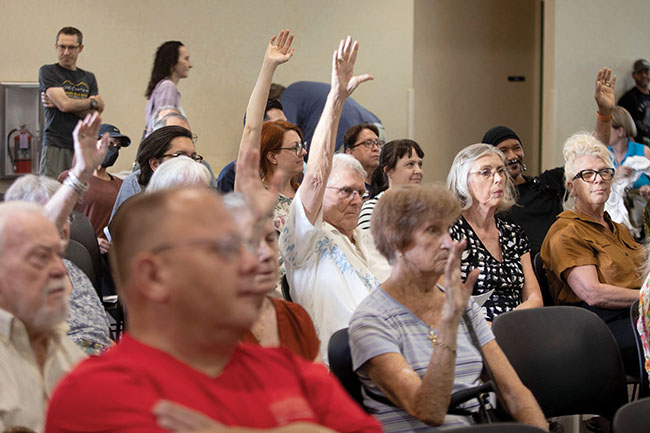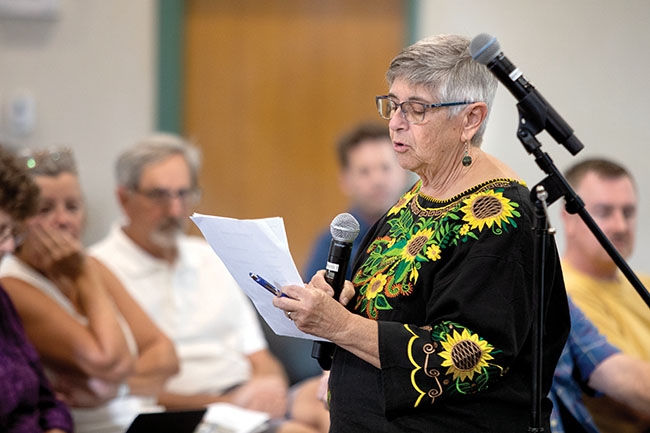Residents speak up on Mountain Avenue redesign

Attendees raise their hands to speak during last week’s meeting on Claremont’s plans to reconfigure traffic patterns on Mountain Avenue. Courier photo Steven Felschundneff
by Steven Felschundneff | steven@claremont-courier.com
The City of Claremont hosted a meeting last week to solicit public input about the proposed redesign of Mountain Avenue, which will include traffic flow changes.
People who live on Mountain, and others who will be directly impacted by the project, received advance notice about the meeting so they could weigh in on what would work best for their neighborhood.
Vincent Ramos, the city’s associate engineer, provided a brief overview of the project but no decisions were made at the meeting.
“We also have the City of Claremont’s complete streets policy that we also have to follow, which was adopted by the City Council, I believe, in 2018,” Ramos said. “Each project is unique. We are bound to certain control points to design these projects that we’re directed to by City Council. Those issues are existing right-of-way, curb to curb distances, land uses, and driver approach spacing, and in this particular presentation addressing class IV [bike lane] requests.”
A “class IV” lane is a raised median between bicycles and moving cars.

Kathleen McCall speaks during at last week’s information gathering meeting about proposed changes to Mountain Avenue in Claremont. Courier photo Steven Felschundneff
Mountain Avenue has been the focus of residents’ ire for some time due to the high rate of speed at which many motorists travel on the north-south corridor. Three of Claremont’s public schools and several popular day care centers are on Mountain, which means traffic, particularly in the morning, can be quite heavy. And then there is the question of safety.
Parents have asked the City Council to implement safety improvements around the campuses, in particular for children who walk or ride bikes to school. One idea was to create a class IV dedicated bike lane that would be separated from the lanes of traffic by a median.
“With school route safety in mind, staff applied for a spot in the Complete Streets Safety Assessment (CSSA) program, as a valuable opportunity to learn from the UC Berkeley experts through CSSA process,” read a city staff report. “In March 2022, UC Berkeley conducted an assessment on Mountain Avenue from Base Line Road to Bonita Avenue to evaluate potential complete street features for Mountain Avenue, as a corridor project.”
Following the UC Berkeley assessment and work conducted by Advantech Consulting Engineers, the city adopted a plan to reengineer traffic on Mountain, including reducing the travel lanes for cars from four to two and creating a dedicated bike lane just adjacent to a curbside parking lane.
In January the council approved a contract with KOA Corporation to complete the design portion of the project. As proposed, the remake of Mountain will include scraping and resurfacing the street with rubberized asphalt; ensuring all ramps at intersections are complaint with the Americans with Disability Act; reconfiguring the lanes of traffic, adding a dedicated bike lane and eliminating two lanes for cars; and adding two mid-block pedestrian crossings, one at Hood Drive and another at Butte Street.
The proposal includes creating “bulb outs” at several locations, including the Scripps Drive and Harrison Avenue intersections with Mountain, and the newly added mid-block pedestrian crossings. Bulb outs are extensions of the curb and sidewalk several feet into the roadway which decrease the distance one has to walk to cross the street. They also create the visual impression that the street is narrower, which has the added benefits of reducing vehicle speeds and improving the ability of pedestrians and motorists to see each other.
The described improvements largely apply to Mountain between Base Line Road and Harrison because the street is wide enough to accommodate the added bike lane. Mountain narrows significantly between Harrison and Bonita, which limits the options for implementing bicycle and pedestrian safety measures. However, the plan does call for creating bulb outs on Santa Clara Avenue in front of Mountain View Elementary School.
A few of the public safety upgrades have already been added, such as “no right turn on red” signs at Scripps and Mountain for the morning and afternoon hours when students are present. In addition, at the intersection of Scripps and Mountain, signal timing modifications have been made, which give pedestrians a few seconds to begin to cross the street before the light turns green for cars. This helps prevent motorists from trying to “beat the crowd” by making a quick right turn on a green light before walkers leave the curb.
“The preliminary cost estimate to implement a Complete Streets project on Mountain Avenue from Base Line Road to Bonita Avenue is estimated at approximately $6 million,” read the staff report. “The City Council appropriated $3 million in the 2022/24 Capital Improvement Program (CIP) budget for this project. Additional funding will need to be identified to close the funding gap.”
Though the intended audience was Mountain Avenue residents, the meeting garnered interest from the broader community, including those advocating for increased safety measures for cyclists. Public comment was fairly evenly divided between those who favor the city’s current plan to have the bike lane separated from traffic by a painted stripe, known as a “class II” lane, and the cycling community, which favors a “class IV” lane, which again is a raised median between bicycles and moving cars.
In order to build class IV lanes, nearly all of the on-street parking would be eliminated, which was the main issue brought up by Mountain Avenue residents. They asked city staff where friends and family would park when visiting or where commercial drivers would leave their trucks when making a delivery. Another issue was where the refuse cans would be placed on trash days.
Advocates for the class IV lane countered Claremont should prioritize pedestrians and bicyclists over cars and said eliminating the left hand turn lane on Mountain could provide enough room for both the bike lane they preferred and on-street parking.
“I walk and bike daily in the area of Harrison and Mountain and I support wholeheartedly having a class IV protected bike lane,” said David Kekone. “I feel like we need to prioritize the health and safety of residents of Claremont.”
“We are convinced, my partner and I, that a parking lane and a class II bike lane would be far more appropriate for a residential neighborhood,” Mountain Avenue resident Kathleen McCall said. “Many residents are elderly or disabled [and] have food deliveries. Where are they going to park? We have older friends who come to visit who use walkers. Are they expected to cross over Mountain to park or hike from a distant site?”
The next step will be to work with KOA Corporation to address the comments received at the meeting. The proposed project will then go before Claremont’s Traffic and Transportation Commission, and then on to City Council for final funding.









0 Comments